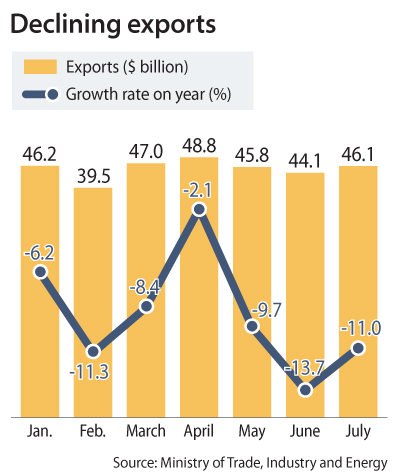Exports fall 11% and inflation remains low

The Ministry of Trade, Industry and Energy reported Thursday that exports from Korea were $46.1 billion in July, down 11 percent from $51.8 billion a year earlier.
July’s decline was the eighth consecutive month of on-year declines in exports, although the rate was slightly lower than June’s 13.7 percent.
The government said that Tokyo’s restrictions on exports of three key semiconductor materials - photoresists, fluorinated polyimide and hydrogen fluoride - had a limited impact on July’s overall figures, although Japanese imports declined 9.4 percent. The restrictions went into effect July 4.
Imports of precision chemical products from Japan, which include hydrogen fluoride, tumbled 39.4 percent. The government said that hydrogen fluoride account for a negligible portion of that category.
The government would not disclose exact changes to the import figures for the three materials as that could influence the direction of talks with Japan. It added that according to its discussions with the industries affected, the materials from Japan have not been imported since July 4.
Analysts say the steady decline in exports will make it more difficult to reach the Bank of Korea’s revised forecast of 2.2 percent gross domestic product (GDP) growth for the year. The central bank slashed its outlook by 0.3 percentage points last month. The Ministry of Economy and Finance targets growth of 2.4 percent to 2.5 percent this year.
“It will be difficult for the country to reach even 2 percent growth this year,” said Kim Tai-gi, a professor of economics at Dankook University. “Exports are down, investment is lagging and consumption is slow.”
According to Statistics Korea data, facilities investment in June rose just 0.4 percent from the previous month, while the retail sales index, which serves as an indicator of consumption, declined 1.6 percent.
Total industrial output in June fell for the second consecutive month by 0.7 percent from the previous month, due to a slump in output by the services sector.
The domestic economy also faces low inflation, signaling low demand.
The statistics agency said Thursday that consumer prices rose 0.6 percent in July from the previous year, marking the seventh consecutive month of inflation remaining below 1 percent.
The agency cited stabilized global oil prices and policies such as increased health care coverage for the prolonged low prices, dismissing concerns of deflation.
But private sector analysts have been warning of deflation since May.
Private think tank Hyundai Research Institute described the situation in May as “quasi-deflation” as the country’s inflation rate remained under 1 percent throughout this year.
“With domestic consumption and investment all slowing along with difficult employment conditions, household consumption is unable to expand and this downward pressure on inflation in terms of demand is the cause of the recent trend of low inflation,” said the institute in the May report.
The government has encouraged the passing of a 6.7-trillion-won ($5.6-billion) supplementary budget to stimulate the economy. The budget currently awaits approval from the National Assembly. But even that might not be enough to combat the growing risk from export restrictions by Japan.
“A 7-trillion-won budget will not solve the problems underlying Korea’s economic situation […] in addition to the trade row,” explained Kim. “There needs to be a change in policy direction.”
The government has already spent 65 percent of this year’s 291.9 trillion won budget to try to stimulate the economy. That helped result in a 1.1-percent rise in Korea’s GDP growth in the second quarter from the previous quarter. Government spending increased 2.5 percent between April and June compared to the first quarter, and on year, it grew 7.3 percent.
The central bank has warned that the key factor for growth for the rest of the year is private sector investment and exports.
The outlook for both exports and investment, however, remains dim because of the expanding trade dispute with Tokyo.
Japan is expected to remove Korea from a so-called white list of 27 countries receiving preferential treatment as early as today through a cabinet meeting decision. The measure could tighten exports of around 1,100 products from Japan to Korea, covering autos, steel, chemicals and electronics.
Although the impact and the extent of that export control measure are currently unclear, the removal from the white list is expected to take a toll on Korean industries due to their heavy reliance on Japanese imports.
As of last year, Korea was Japan’s third-largest export destination. Of Korea’s trade partners, its trade deficit with Japan is the largest, at $24.1 billion.
According to an analysis by the Korea Economic Research Institute (KERI), Korea’s total GDP could fall by 2.2 percent if there is a supply shortage of semiconductor materials by 30 percent as a result of the ongoing trade dispute.
As headwinds at home and from abroad grow, the administration’s signature policy to encourage economic growth through rises in household incomes has failed to produce meaningful results.
Although the government pushed to increase the minimum wage by 29 percent over the past two years, GDP growth was 2.7 percent last year, the slowest in six years.
The government recently shifted to encourage private investment through announcements last month of tax breaks in facilities improvement and increasing the types of industries that receive tax credits for research and development.
BY CHAE YUN-HWAN [chae.yunhwan@joongang.co.kr]










with the Korea JoongAng Daily
To write comments, please log in to one of the accounts.
Standards Board Policy (0/250자)